Since early fall, the Oregon Department of Transportation has often mentioned stakeholders who oppose a proposal to re-stripe about 1.5 miles of Southwest Barbur Boulevard, replacing one northbound lane to create room for two bike lanes.
“Over the past several months, ODOT has received both strong messages of support for a road diet and strong objections from stakeholders who feel that reducing motor vehicle capacity on Barbur/99W would create unacceptable impacts for commuters, businesses, transit, and freight operations,” ODOT’s Jessica Horning wrote in a Sept. 5 memo.
The current design pushes bikes and cars into the same 45-mph auto lane as they cross two narrow bridges. Barbur has been eyed for bikeway improvements for many years as it’s the only flat link between most of Southwest Portland and the rest of the city.
But there are many factors at play here, so we wanted to give other views a fair airing and if possible get in touch with these stakeholders to include their comments for our stories. So, on Sept. 11, we asked ODOT to share the messages it was referring to. Two days ago, after a formal records request, the agency did.
Since Jan. 1, ODOT’s records show, it’s received direct communications about the proposal from 29 different organizations or individuals, not counting several repeats. Of those, 23 (including several we’ve reported already, such as Southwest Neighborhoods Inc., the City Club of Portland, Lewis and Clark College, Oregon Walks, the Portland Bicycle Advisory Committee and the Bicycle Transportation Alliance) supported analysis of a road diet.
The other six letters opposed further work on it.
Of course, there are many people on both sides of this subject who haven’t communicated directly with ODOT, and many thousands more who aren’t aware of the debate at all. But in hope of helping everyone understand each other a bit better, here’s what the six opponents said. Click them to enlarge:
“All lanes are needed for cars/buses etc.” That was the take on Jan. 16 from Patti Waitman-Ingebretsen:
“The vast majority of Portlanders, myself included, rely primarily on automobiles for travel.” That’s from Casey Holdahl, on Jan. 17:
“Any reduction in vehicular capacity is highly undesirable and irresponsible in the long run.” Until this year, a Barbur road diet was nothing but a concept. But according to the Metro traffic engineer on the project, preliminary studies completed this spring and summer showed that re-striping this stretch of Barbur would reduce traffic speeds, especially during the morning rush, by as much as a few minutes, and would therefore divert some traffic onto other streets. The number of vehicles the road can carry in a given hour, on the other hand, would barely change.
“The capacity constraint remains at the signal at Terwilliger at the south end,” Metro’s Anthony Buczek said in a Sept. 11 interview. “It does slow things down, because the slowest car’s going to dictate the flow of traffic when you only have one lane. But it doesn’t really reduce the capacity, or at least not very much.”
On Sept. 12, responding to news coverage about this tradeoff, Randy Evans sent ODOT this letter of praise for the agency for their “continued resistance from the PDX bike lobby…” (among other things):
“Southwest Barbur Boulevard is a key inter-city road and an important relief valve when Interstate 5 is backed up due to accidents.” That’s from the Portland Business Alliance, the area’s chamber of commerce, in a two-page letter to city officials, and apparently also to ODOT, on Oct. 7:
“The corridor is of regional significance and warrants an increase, as opposed to a reduction, in capacity.” On Oct. 8, the Portland Freight Committee weighed in with a letter to Portland Transportation Commissioner Steve Novick (see also our previous coverage of the full letter):
“One lane each way on Barbur will never work. Too much traffic on Barbur.” That’s from the final anti-road-diet correspondent, Sue Conachan, on Oct. 15:
Conachan’s letter arrived soon after the most recent development about the future of Barbur: Portland City Council’s Oct. 9 decision not to require ODOT to fast-track a more detailed study of restriping Barbur. Novick said at the time that he would make his preferences on the issue public “in the coming months.”
As Novick said at the time: “Just as there are people who people passionately in favor of a road diet, there are also people who are concerned about it.”
True enough.



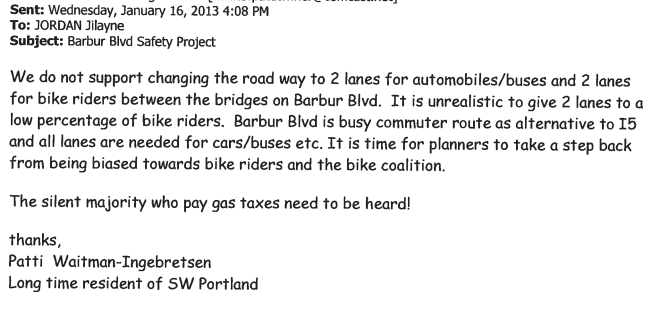

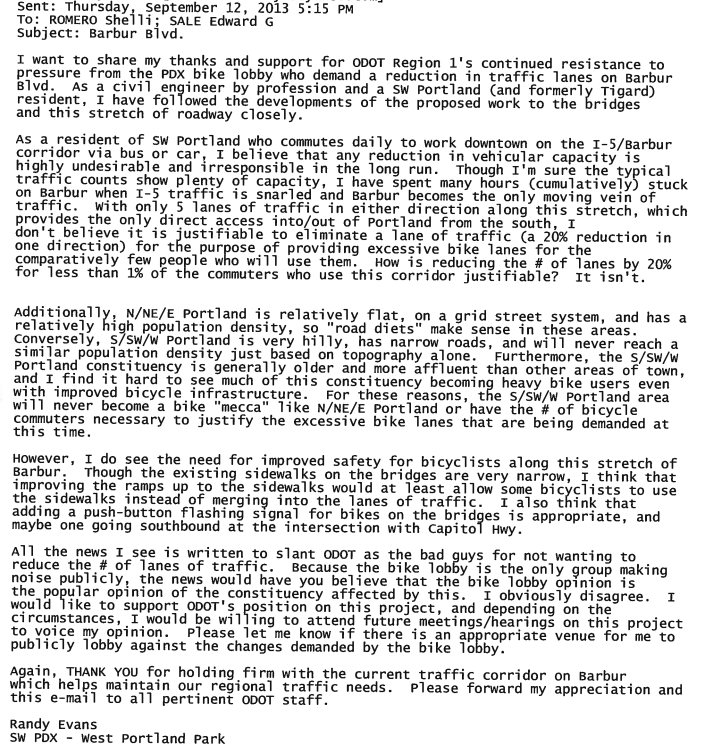
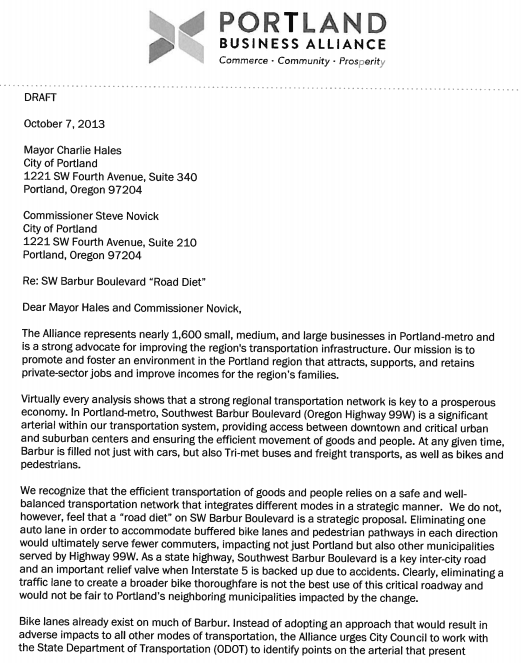
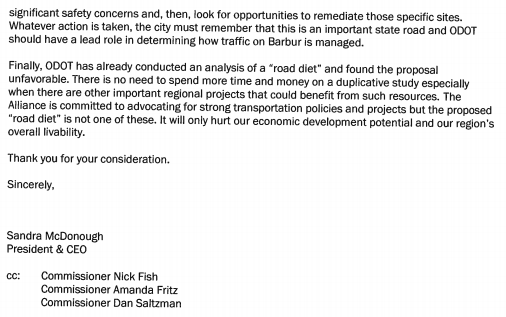

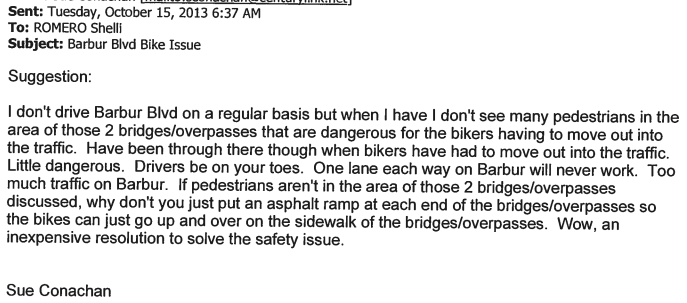
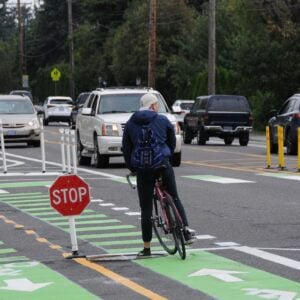

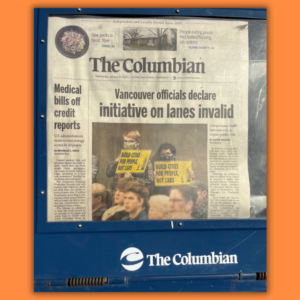
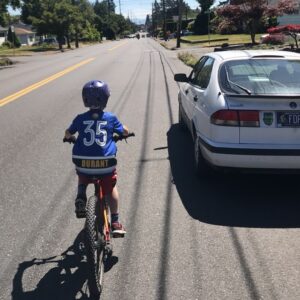
Thanks for reading.
BikePortland has served this community with independent community journalism since 2005. We rely on subscriptions from readers like you to survive. Your financial support is vital in keeping this valuable resource alive and well.
Please subscribe today to strengthen and expand our work.
And just like Fox News, ODOT treats a handful of opponents, some of whom are individuals who admit to not using Barbur much, as balance to the, apparently overwhelmin, preference for a road diet. Nice work, Bikeportland!
At present what the info provided in this bikeportland story says, is that from “…direct communications about the proposal from 29 different organizations or individuals, not counting several repeats…”, 23 out of 29 supported analysis of a road diet.
The stories info says it’s the analysis of a road diet that the majority in this case, supports, rather than the road diet itself.
What percent of people as road users that are obliged to drive Barbur or travel it by motor vehicle…the overwhelming majority…support a road diet or are willing to pay to put it in place, and remove it if it doesn’t work out, remains to be seen.
It’s pretty clear that these people have never really taken a close look at what’s going on there, they’re still clinging to the notion that those bridges have “sidewalks,” which is something that happens when you only glance at them at 45mph.
We wouldn’t want to promote a seldom-used conveyance. No sir. That would go against Natural Law, God, and who knows what else.
Pearl Clutching… lots of hypotheticals they seem to be worried about here.
Also, lots of crafty language basically lumping Barbur and 1-5 together as if they are one road. What’s up with that? Are Clinton and Division “Three lanes of East/West travel”? Admitting that you bounce onto Barbur when traffic backs up on 1-5 seems like a bad tactic. That’s like saying, “Oh, if Division is bad, I just hop over to Clinton.”
Whenever the traffic backs up on I-5, the traffic on Barbur is also horrible. What’s going to change with a road diet?
What’s also dumb is that none of these snarls seem to take place at these bridges. It’s mostly by Barbur Foods, Swan Mart and Fred’s.
Why don’t they ride on the sidewalk going across the bridge?
Narrow surface, low railing, high curbs, 85 foot drop.
I myself ride on those “sidewalks”. If it scares you walk your bike across or take Terwilleger.
It seems like that argument cuts both ways.
If you don’t want bikes in the primary lanes, you can always drive on Terwilliger where they have a consistent, dedicated lane.
hear, hear.
Comparing Terwilliger to Barbur for someone on a bike is, I think, telling. Sure they are parallel, more or less. But let’s talk about elevation gain/loss. There is a reason the Red Electric ran on Barbur and not Terwilliger.
This is the kind of attitude that is going to help us increase our bike modal share…
We have heard these same ‘sky will fall’ arguments recently when Interstate Avenue capacity was reduced from four to two lanes (for LRT) and as far back as when the Harbor freeway was removed from waterfront in downtown. Somehow we have survived. ODOT needs to stop designing our roadways to minimize motor vehicle delay at AM and PM peak periods, it’s a losing battle.
If they do not want the affordable road diet option, then fine let them have it.
In response, they need to come up with the cash to build a four set of six foot wide one-way paths with railings which would wrap around the exterior of the bridges. These could be bolted to the bridge supports…or there can be an elevated path with two railings above the “Barbur Freeway” they desperately desire to keep that could be a full 8 feet wide.
It certainly would have nice views and would place us above cars stuck in traffic. Oh yes….cycle-track the rest of the bike lane from Hamilton to Terwilliger to no more citizens get run over.
The current situation, or ODOT’s flashing yellow “compromise,” is unacceptable.
Wait a minute. There’s just these 6 letters? This is it? This is the opposition to a road diet?! I thought this was a sampling, not the total. This is bogus.
All letters are equal but some **cough**PBA**cough** are more equal than others.
Yes, the Professional Bowlers Association is very intimidating.
Agree with Terry D. While perhaps it’s not ideal to reduce lanes for motor traffic (I’m all for road diets whenever possible) it seems like at least we can build some cantilevered bike paths on the bridges.
The bridges are an obvious issue, but you need to look at the road as a whole. You’ve got at least two spots where 45mph car traffic merges through bike traffic (Capitol SB, and the Naito/RIB split NB) and people just drive too fast on the road (Look at the number of excessive speed crashes). The whole road is a problem that needs to be addressed, and the focus on those bridges really doesn’t do it justice.
Good point about merging across bike lanes. That is a big issue for N Greeley, which is supposedly a “mecca” for bikes (and part of N PDX, which is “flat” according to one commenter who has clearly never been to N PDX).
To any opponents reading… here’s a danger scenario that plays out almost daily, and has nothing to do with traffic…
A bike will be heading North on Barbur past Kaady Car Wash. There is basically no traffic. The biker approaches the bridge and sees that there is a car 100 yards behind, so they signal and get on the bridge. The car that was 100 yards back happens to be in the lane closest to the railing. Since there is no traffic they are going approx 50mph. I believe there is a desire to hold your line in a car and not merge over to the other open lane so the car basically swerves around the bike with a quick blinker. These drive-by buzzes are what creates a large amount of anxiety to bikers and will end badly soon enough, when two inexperienced bikers and drivers attempt this move on a rainy evening. This has nothing to do with traffic concerns or the desire to “take over” Barbur from cars. It’s just bad design.
As a side note, the most egregious offenders of the drive-by buzz are TriMet, and they give you 0 room to work with if there was like a bottle in the road or something…
So I understand if your commute sucks, but commuting sucks. Let’s all try and not kill each other for starters.
Thank you for the flood of memeories from my five years of commuting that stretch a decade ago. Almost PTSD like….
And the letter writers above would answer “If you don’t want to die, then don’t ride a bike”. I have heard it before. We are “such a small percentage of traffic” so we must be insane, right?
My favorite reason is because of accidents on I-5. It’s basically saying, “look, people can’t drive safely and are always getting into accidents, so we need more lanes so people can drive around those accidents. It would be irresponsible to take away those lanes to make it safer for bikes.”
She wrote her email it in Comic Sans. Ignore everything she says. 😛
She is also very interested in Portland’s history, perhaps at the expense of its future.
“The silent majority who pay gax taxes.” Yes, car drivers are silent–there’s no auto or freight lobby pouring money into making sure the auto remains king of the road–no billions of dollars being used for all the infrastructure that prioritizes autos. Just that pesky “bike coalition” that just pushes these “ludicrous” road diets! Car drivers are really the oppressed people here.
Cry me an effin’ river.
“The silent majority who pay gax taxes.”
And those that travel by motor vehicle, which generally still seems to be 85 percent or more of road users. Logically figures that a majority of them are in turn, people having to pay for whatever will eventually be done with Barbur Blvd. Do these people overwhelmingly, as some would like to think they do…approve spending their money and that of everyone else, on reducing the number of Barbur’s main lanes of travel?
If user fees paid for all of the costs associated with driving, then this argument would hold water.
http://www.oregon.gov/ODOT/COMM/docs/budgetbooklet_11-13.pdf
User fees wasn’t the point I intended to draw emphasis to, but instead, the approximately 85 percent of road users on Barbur that either drive or travel the road by motor vehicle. Whether to proceed with a road diet depends some on how those road users feel about the number of road’s lanes being reduced. What do they think about how their travel experience on the road that could be affected by the proposed road configuration. Also, how do they feel about other possible affects of such a change.
For 9watts, the 85 percent figure is just one I’m drawing from reports periodically offered in the news about what percent travel mode share in Portland is represented by bikes, which seems to be 15 percent, subtract that from 100 gives 85 for motor vehicle travel. Varying of course, depending on a variety of factors. If you differ on that number, and have an alternative, offer it and explain why.
I’ve not read what the bike mode share for Barbur currently is. Have read bike use on that road expressed as somewhere between 800, and I think, 1600 trips a day. In a Joe Rose, Oregonian story, not sure where he got it. What percent of the road’s traffic that represents, someone else can figure out.
More people favoring this road diet might think about offering some idea of a number increase in bike mode share that may occur as a result of a road diet. Especially if it were to be a significant increase, that could be a selling point for the idea. Same for costs of project construction too. Ordinary citizens, more of them that is, should be thinking about and getting some idea of what various projects besides the biggies like the CRC, are going to cost them, before they say yay or nay.
“the 85 percent figure is just one I’m drawing from reports periodically offered in the news about what percent travel mode share in Portland is represented by bikes, which seems to be 15 percent, subtract that from 100 gives 85 for motor vehicle travel.”
Wait a minute. Bikes are hardly the only non-car mode. Many, many people walk and/or take the bus (and neither bike nor drive).
Buses are motor vehicles; people riding them are traveling by motor vehicle, which I’ve noted when writing: “…road users on Barbur that either drive or travel the road by motor vehicle. …”.
Keeping in mind distance they individually tend to travel on foot, or other type of walking they do on the road, percent of people walking Barbur could be a valid travel mode user group by which to support reconfiguration of the road through in part, a reduction in number of the road’s lanes for a road diet. If many people walk lengthier distances along Barbur (a use that perhaps would justify creating an MUP or some such thing), other than getting off a bus and crossing the road, I don’t think I’ve read of that.
“And those that travel by motor vehicle, which generally still seems to be 85 percent or more of road users. Logically figures that a majority of them are in turn, people having to pay for whatever will eventually be done with Barbur Blvd. Do these people overwhelmingly, as some would like to think they do…approve spending their money and that of everyone else, on reducing the number of Barbur’s main lanes of travel?”
(1) As Chris just pointed out, gas taxes don’t come close to paying for this infrastructure.
(2) as RJ has noted, this isn’t about cutting out capacity for those in cars; it is a far more interesting, nuanced, win-win change.
And where do you get that 85% figure? person miles? car ownership? commute share?
I’m not saying it is the wrong number, but as Glowboy noted, the share of those who do not drive on Barbur, or make do biking somewhere else that is less gently sloped, can’t but rise if a road diet with some accompanying changes were implemented.
If only they would build the silent majority some dedicated travel corridor with between 2 and 3 lanes where they could travel in peace, free from the moocher cyclists.
The argument that there’s “hardly any” pedestrians or cyclists does not demonstrate or prove a lack of people that would want to use this facility. All it proves is that currently the facility underserves those people. Clearly there is public interest in using this stretch for cycling and walking – and clearly there’s an inherent danger to those users that could be mitigated with a road diet which would not affect road capacity.
I also take issue with trying to peg this as the “PDX bike lobby” when it’s really a public safety issue. If there’s any “lobby” being pandered to it’s the same-ol’-same-old club that’s pulling a NIMBY attitude.
Thanks Michael for jumping through the hoops to bring these letters to light. Too often the levers of power are manipulated by operators unseen to the public.
I’m really curious about the Portland Business Alliance letter. Sandra McDonough puts her name on plenty of letters, but how does her organization actually decide when and how to get involved?
Was every member of the PBA board [1] (including PCC, KGW, TMT Development, the Oregonian, PGE, Alaska Airlines, Nike, Intel, Macy’s, Portland Timbers, Kaiser Permanente, CH2M Hill, Columbia Sportswear, Moda Health, OHSU, U of O, TriMet and PSU) in agreement on this?
1: http://portlandalliance.com/about/board-of-directors.html
I’m concerned that you included the names of individual stakeholders with these comments. Large groups like PBA, sure, that’s fine. What does it add to the conversation to call out individuals that took the time to participate in a public process? Everyone is entitled to their opinion.
Is there anyway you can remove the people’s names from this article? I think it detracts from your credibility and makes me, as a citizen, a little afraid of submitting comments in the future.
James John, good question. It’s something I thought about. Though we definitely don’t want to discourage anyone from sharing their opinion, I don’t think someone who communicates with a public agency has (nor should they have) an expectation of privacy. Who they are is a relevant part of what they’re saying. When you’re contributing your perspective to a matter of legitimate public debate, as there is here, being identified is just a safe, normal and healthy part of the process.
Readers may disagree with these opinions, but good for these folks for caring enough to share them.
More generally, the names are valuable to this story because opponents of the road diet mention at every opportunity that there is opposition. Identifying who these people are helps put that statement in a better context.
You might have noticed that the images above clip out the email addresses of private individuals who weighed in. That’s deliberate.
Yes, but as this week’s WW cover story pointed out, we are just one Google search away from getting access to tons of information about someone, much of which can be taken out of context and can lead to unintended consequences (Vahid Brown being afraid to leave his house, for example). A name in today’s world might as well be contact information. It took me minutes to find this information for folks listed here.
I understand that you feel comfortable with your name and opinions being linked (especially as you are writing on an activist blog where most people agree with you), but given the context in which these individuals provided their names–I don’t think this is what they thought they were signing up for and I’m not sure they would have provided it if they knew this was a possibility. After all, public comment summaries, as you pointed out, typically anonymize comments to add a layer of privacy for citizens. An important consideration when discussing topics that can become heated. The comments on this article have already lobbed personal attacks on these citizens.
I’ve linked to the WW article below in case you have not read it. You might notice that at least one person interviewed in this story has been featured on this blog (Noeker) for accusing an Asian man of being an undercover cop.
Given the personal attacks I’ve seen thus far in the comments and the history of some of your commenters making BIG personal accusations that have impacted people, I can’t understand how the potential for unintended consequences of the information you’ve provided does not outweigh the benefits you suggest exist.
http://www.wweek.com/portland/article-21434-whack_a_mole.html
If you want a public debate, it must be public. Allowing anonymous individuals to take pot shots from the side lines can have the effect of slanting perceived support or rejection of public policy. I do support not posting addresses, but names are important to show that these are real people.
if the witch-hunting were a figment of our imagination, you would be right. james john has a point – the community here has overlap with another community that takes their ideology to a level most of us don’t.
It’s odd how often those who use language like “extremism” rarely have the courage to provide a single example.
James John, I appreciate your take on this. I did read the WW piece; thanks. If these communications were of a different nature, or if any were particularly inflammatory, I might well agree. But in my view they’re the equivalent of someone testifying at a public hearing, at which sharing one’s name and home or work address is the standard practice. In my opinion, voluntarily taking part in the political process is a public action and under most circumstances that means identifying yourself by name.
That said, I hear you on the possibility of personal attacks online and ask readers to be civil in any criticisms. If your attacks are overly personal, your comment won’t be posted.
Thank you
Personally, I have been engaged in discussing a (non-cycling) issue that is (underservedly) subject to extreme overreactions in discourse online and have never received any harassment online or otherwise. I appreciate your concern about releasing people’s names, but I think you exaggerate the probability of harassment, and I think that there is sufficient disclosure to the public comment process that people should be aware that they are not (and should not be) completely shielded from people disagreeing with their public positions.
Sue Conachan,
Your desire to chime in on this makes no sense to me as you not only suggested a solution which is already in place, but you don’t even use Barbur. let me take a picture of the drain that you hit going down the first “Ramp” on the first bridge going south, then you chime back in and let me know if that looks safe to you. But I do hope you get your Oak Grove Wal-Mart.
Further to Michael’s response to James John…
Identifying the citizen commenters who oppose analysis of a road diet gives perspective to the bias in the statement in Jessica Horning’s ODOT memo: “Over the past several months, ODOT has received … strong objections FROM STAKEHOLDERS who feel that reducing motor vehicle capacity on Barbur/99W would create unacceptable impacts ….” To contrast wide-ranging support for the study, Ms. Horning calls out opposing “stakeholders” to bolster the appearance of opposition or the appearance that ODOT is actually balancing comments from the two sides.
Identifying the citizen commenters is a nice way for BikePortland to show directly the basis of ODOT statements about the strength of the opposition. Without editorializing, we readers are free to reach our own conclusions about whether ODOT is being accurate or balanced in its characterization of comments opposing the study. While not literally false, the tone of Ms. Horning’s statement implies a breadth of opposition that doesn’t appear correct to me.
I don’t have any thoughts on the content implications, just that the comments could be assigned to “SW Portland Resident” or “XYZ Neighborhood Resident” to get across the same point.
Also, I’m not sure if the only comments they received were in writing. They likely received verbal comments at events as well.
Obviously, the PBA letter is the big one…and I believe you’ll find a lot of overlap between PBA membership and Portland Freight Committee membership.
These groups are stuck on a very understandable — but superficial — view of what the impacts of the northbound lane removal would be. In their view, removing a travel lane cannot possibly be a good thing, so they are opposed. What I would say to the PBA is:
1. Traffic engineers who have looked at this will tell you that the corridor is constrained by the signals at each end (particularly Terwilliger), so instituting a road diet that doesn’t affect lane configuration at the signals will have nearly no effect on motor vehicle throughput. The Terwilliger signal will continue to meter traffic entering the segment in question (“The Woods” per the Barbur Concept Plan) in the AM, which is the congested time period for travel towards the central city.
2. Adding more space for people walking and biking helps ALL modes. Motor vehicles will be able to operate at the posted speed without bicycles entering the travel lane, which causes dangerous lane changes and slowdowns.
3. The road diet would be an interim measure until SW Corridor improvements (to be determined) are implemented sometime in the 2020s. The 2035 analysis of the road diet, which showed significantly higher motor vehicle volumes, high delays, and high traffic diversion, is therefore irrelevant. As far as the interim…we don’t have a crystal ball to tell us whether there will be more or fewer motor vehicles on the road in 2025 (or 2035), but we do know that volumes on Barbur have been decreasing for the last decade.
4. Traffic engineers have traditionally sized roads to be able to accommodate vehicle volumes at the peak 15 minutes of the peak hour (usually PM) of a weekday during the peak month (usually August). Sort of like sizing your parking lot for Black Friday. This is increasingly seen as an approach that leads to bad outcomes for your transportation system and your public space, particularly in a (supposedly?) forward-looking place like Portland. What’s amazing, though, is that freight advocates go a step further than this even, saying that you not only need all of the usual capacity, but then you need a bunch extra just in case there’s an incident on a parallel freeway. This is beyond absurd. Please name me a corridor planning process where providing redundant capacity in order to accommodate a blue-moon event was even a remote consideration. That’s just laughable, especially in the Portland region. You would never do that. When a truck rolls over in the Terwilliger curves, it just means that it’s a bad day to be driving a car, a few freight deliveries are going to be later than usual. You don’t try to solve the problem by overbuilding your roadway system. I’m shocked that that’s an argument that’s being made with a straight face or that it’s being taken seriously by anyone.
Thanks, RJ, as always.
But I’m not sure the worldview is even that understandable. Timeworn might be more apt. As you point out, thinking people can see through most of this.
Yeah, I look at something like the Foster or Williams project, and those are difficult decisions. There are real tradeoffs there. I don’t even know that there are tradeoffs with the Barbur proposal. Doesn’t everybody win?
Let’s just demand they make the bike lanes in a way that they can accommodate Critical Mass. LOL!
RJ…interesting viewpoint you’ve expressed about the view on the road diet, expressed by some of the people having reservations about the road diet proposed.
By the way, roughly what increase in number of riders, or what percent increase in bike mode share of Barbur’s overall number of road users do you estimate construction of a road diet would bring about on Barbur?
In numerous comments to Barbur-road diet stories at bikeportland, I read anxious appeals expressed for various additions to the road’s existing bike infrastructure, including some that would be achieved in part by a road diet, but never an estimate of how many additional people are expected to start riding Barbur once one, maybe two of the roads’ main lanes of travel are removed, and replaced by continuous bike lanes.
Often Barbur is referred to as having a grade out of town that’s flat, when that’s not actually right…it’s a climb on this road from Duniway to Burlingame that many people would have second thoughts about making. Quite a bit less of a climb than Terwilliger or Corbett but still quite a climb.
Didn’t say where he got the number from, but in an article he wrote recently about Barbur, Joe Rose of the Oregonian said: “…Barbur Boulevard, a former railroad route, offers nearly 800 bicycle commuters a day the closest thing to a flat route. …”. http://www.oregonlive.com/commuting/index.ssf/2013/10/portland_bicycle_advocates_odo.html
Also gives “…30,700 vehicles a day…” for Barbur.
I think people would appreciate some estimate of how many additional people riding a bike, a road diet is anticipated to bring about.
Of course you generally can’t gauge the broader public’s desire for or against a particular project based on public comments. There is usually going to be an imbalance in comments submitted to a public agency whenever you have an issue where there are trade associations, advocacy groups, advocacy blogs, etc. advocating for, urging and sometimes organizing folks to submit comments.
Some common threads in these letters:
– Not enough people bike or walk along Barbur to justify improvements for bikes and pedestrians. Talk about a chicken-and-egg scenario! The REASON not many people bike or walk on Barbur is BECAUSE of this design. Sheesh! I will occasionally ride it myself on the way home from Beaverton, but even I avoid it on most days because of the horrible design. Build it, and they WILL come. SW will never have the same level of bike traffic as the flatter parts of inner and east portland, but it probably has the greatest share of UNMET demand, people who would bike if they could but there isn’t a satisfactory route. And Barbur would provide an option for a lot of those people.
– “Thanks” to ODOT for “standing up” to the powerful “bike lobby”. Once again, the oppressors twist things around to make themselves look oppressed. GMAFB!
As for making the sidewalks usable for cyclists, well it’s not exactly a road diet but it would still surely make my life easier. Although the sidewalks are too narrow to comfortably share with (rarely seen) pedestrians or to walk next to your bike, they are there. Improved ramps on and off the sidewalks, along with higher railings, would at least make Barbur marginally acceptable to me.
BTW, asking people to stop from 25mph, dismount and walk their bikes on the bridge is unacceptable, unless we’re also going to ask motorists to stop, shift their cars to first gear and drive that way all the way across each bridge.
Perfectly stated. You could turn this into your own letter with some minor tweaks. 🙂
The All-Powerful Bike Lobby is at it again!
These letters show how important a decent traffic analysis would be. We have our opinion about the little traffic in Barbur and the letter writers think that the traffic volume is so high that they can’t possibly go with one lane less. So if we had numbers about traffic on Barbur as well as about a possible impact on the neighborhood streets an informed decision could be made, not just one based on hearsay and opinion.
Also, it is amazing how many misconceptions people have about the road diet idea. It seems some think if will be all of Barbur (PBA for example), others think that it would go from 4 lanes to 2 not to 3. And then most letters writers have misconceptions about the bridges and the feasibility of the “sidewalks”. So with real numbers and some public outreach it could be possible to appease those opponents.
I know that re-stripping is much cheaper than multi-use paths, but why aren’t we asking for a MUP here as our primary goal and better bike lanes as a concession? Riding on a MUP is so much more enjoyable than in a bike lane on fast road, especially with kids, so this would definitely increase the number and types of cyclists. (Disclaimer: I haven’t ridden this stretch yet.)
Funny, I had the same thought. The speed of the cars asks for a cycletrack, not just a bikelane. So we should ask for that and then we can compromise on the buffered bike lane…
Space constraints and costs. This road is carved into the side of a hill. To add more width (necessary to add a path without touching auto capacity) would be much more expensive. additionally it would do nothing to reduce high speeding crashes/deaths that have been prevalent on Barbur.
All of you folks who are posting well-reasoned arguments for bike lanes here — be sure you also send those arguments in to ODOT and other authorities.
A well written argument can sway decisions.
Whenever this issue comes up, fire off another letter. There’s at least a dozen elected officials and city/metro/state employees that have some sway in this decision, make sure their communication lines are getting lots of “pro” letters for every one of these opposition letters that comes through their inbox.
And consider more than email. Print it out on bond paper, sign it with a good quality pen, and send in a hard copy. Give them something tangible.
Ted Buehler
when I see BIKE LANE ENDS my heart drops or skips a beat.